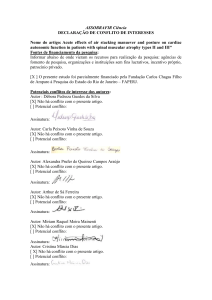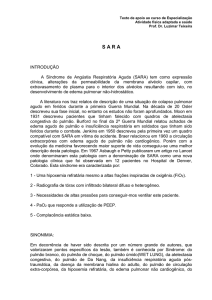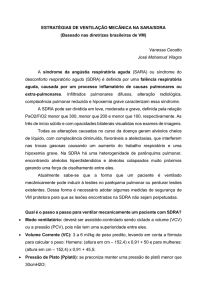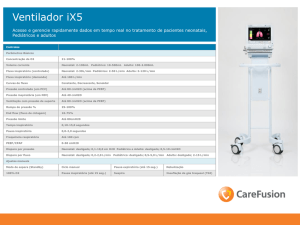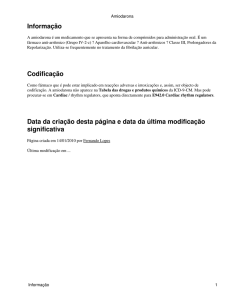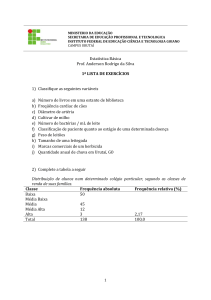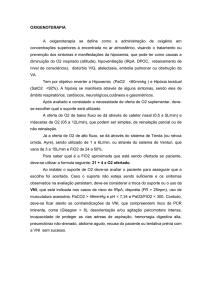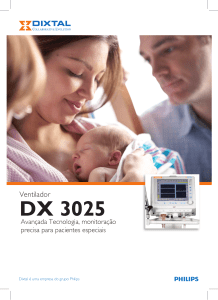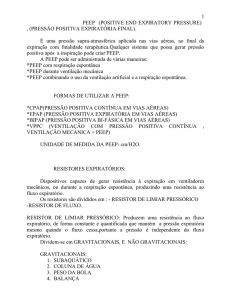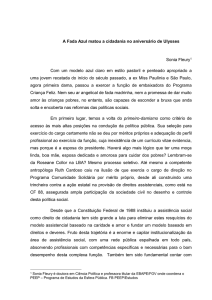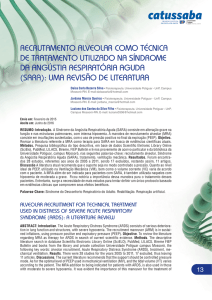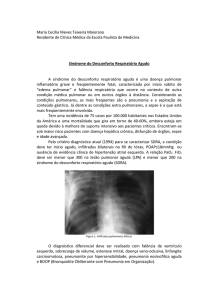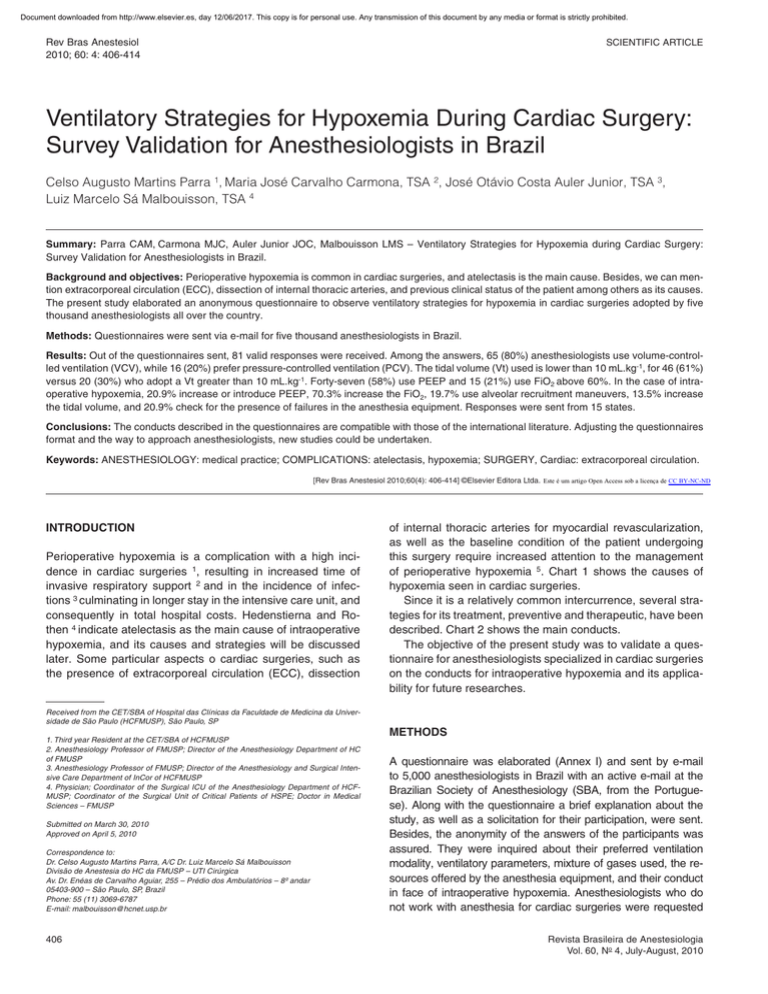
Document downloaded from http://www.elsevier.es, day 12/06/2017. This copy is for personal use. Any transmission of this document by any media or format is strictly prohibited.
Rev Bras Anestesiol
2010; 60: 4: 406-414
SCIENTIFIC ARTICLE
Ventilatory Strategies for Hypoxemia During Cardiac Surgery:
Survey Validation for Anesthesiologists in Brazil
Celso Augusto Martins Parra 1, Maria José Carvalho Carmona, TSA 2, José Otávio Costa Auler Junior, TSA 3,
Luiz Marcelo Sá Malbouisson, TSA 4
Summary: Parra CAM, Carmona MJC, Auler Junior JOC, Malbouisson LMS – Ventilatory Strategies for Hypoxemia during Cardiac Surgery:
Survey Validation for Anesthesiologists in Brazil.
Background and objectives: Perioperative hypoxemia is common in cardiac surgeries, and atelectasis is the main cause. Besides, we can mention extracorporeal circulation (ECC), dissection of internal thoracic arteries, and previous clinical status of the patient among others as its causes.
The present study elaborated an anonymous questionnaire to observe ventilatory strategies for hypoxemia in cardiac surgeries adopted by five
thousand anesthesiologists all over the country.
Methods: Questionnaires were sent via e-mail for five thousand anesthesiologists in Brazil.
Results: Out of the questionnaires sent, 81 valid responses were received. Among the answers, 65 (80%) anesthesiologists use volume-controlled ventilation (VCV), while 16 (20%) prefer pressure-controlled ventilation (PCV). The tidal volume (Vt) used is lower than 10 mL.kg-1, for 46 (61%)
versus 20 (30%) who adopt a Vt greater than 10 mL.kg-1. Forty-seven (58%) use PEEP and 15 (21%) use FiO2 above 60%. In the case of intraoperative hypoxemia, 20.9% increase or introduce PEEP, 70.3% increase the FiO2, 19.7% use alveolar recruitment maneuvers, 13.5% increase
the tidal volume, and 20.9% check for the presence of failures in the anesthesia equipment. Responses were sent from 15 states.
Conclusions: The conducts described in the questionnaires are compatible with those of the international literature. Adjusting the questionnaires
format and the way to approach anesthesiologists, new studies could be undertaken.
Keywords: ANESTHESIOLOGY: medical practice; COMPLICATIONS: atelectasis, hypoxemia; SURGERY, Cardiac: extracorporeal circulation.
[Rev Bras Anestesiol 2010;60(4): 406-414] ©Elsevier Editora Ltda. Este é um artigo Open Access sob a licença de CC BY-NC-ND
INTRODUCTION
Perioperative hypoxemia is a complication with a high incidence in cardiac surgeries 1, resulting in increased time of
invasive respiratory support 2 and in the incidence of infections 3 culminating in longer stay in the intensive care unit, and
consequently in total hospital costs. Hedenstierna and Rothen 4 indicate atelectasis as the main cause of intraoperative
hypoxemia, and its causes and strategies will be discussed
later. Some particular aspects o cardiac surgeries, such as
the presence of extracorporeal circulation (ECC), dissection
of internal thoracic arteries for myocardial revascularization,
as well as the baseline condition of the patient undergoing
this surgery require increased attention to the management
of perioperative hypoxemia 5. Chart 1 shows the causes of
hypoxemia seen in cardiac surgeries.
Since it is a relatively common intercurrence, several strategies for its treatment, preventive and therapeutic, have been
described. Chart 2 shows the main conducts.
The objective of the present study was to validate a questionnaire for anesthesiologists specialized in cardiac surgeries
on the conducts for intraoperative hypoxemia and its applicability for future researches.
Received from the CET/SBA of Hospital das Clínicas da Faculdade de Medicina da Universidade de São Paulo (HCFMUSP), São Paulo, SP
1. Third year Resident at the CET/SBA of HCFMUSP
2. Anesthesiology Professor of FMUSP; Director of the Anesthesiology Department of HC
of FMUSP
3. Anesthesiology Professor of FMUSP; Director of the Anesthesiology and Surgical Intensive Care Department of InCor of HCFMUSP
4. Physician; Coordinator of the Surgical ICU of the Anesthesiology Department of HCFMUSP; Coordinator of the Surgical Unit of Critical Patients of HSPE; Doctor in Medical
Sciences – FMUSP
Submitted on March 30, 2010
Approved on April 5, 2010
Correspondence to:
Dr. Celso Augusto Martins Parra, A/C Dr. Luiz Marcelo Sá Malbouisson
Divisão de Anestesia do HC da FMUSP – UTI Cirúrgica
Av. Dr. Enéas de Carvalho Aguiar, 255 – Prédio dos Ambulatórios – 8º andar
05403-900 – São Paulo, SP, Brazil
Phone: 55 (11) 3069-6787
E-mail: [email protected]
406
METHODS
A questionnaire was elaborated (Annex I) and sent by e-mail
to 5,000 anesthesiologists in Brazil with an active e-mail at the
Brazilian Society of Anesthesiology (SBA, from the Portuguese). Along with the questionnaire a brief explanation about the
study, as well as a solicitation for their participation, were sent.
Besides, the anonymity of the answers of the participants was
assured. They were inquired about their preferred ventilation
modality, ventilatory parameters, mixture of gases used, the resources offered by the anesthesia equipment, and their conduct
in face of intraoperative hypoxemia. Anesthesiologists who do
not work with anesthesia for cardiac surgeries were requested
Revista Brasileira de Anestesiologia
Vol. 60, No 4, July-August, 2010
Document downloaded from http://www.elsevier.es, day 12/06/2017. This copy is for personal use. Any transmission of this document by any media or format is strictly prohibited.
VENTILATORY STRATEGIES FOR HYPOXEMIA DURING CARDIAC SURGERY: SURVEY VALIDATION FOR ANESTHESIOLOGISTS IN BRAZIL
Annex I – Questionnaire on the use of mechanical ventilation during cardiac surgery in Brazil
How do you adjust the following parameters of the respirator during cardiac surgery?
1. Ventilation Modality Used
Pressure-controlled ( ) Volume-controlled ( ) SIMV (
)
2. Tidal Volume: __________________ (in mL/kg)
3. If you use pressure-controlled ventilation, which is the maximal pressure limit: ___________ (cmH2O)
4. Respiratory rate: ______________ (bpm)
5. Do you commonly use positive end-expiratory pressure (PEEP)?
YES (
)
NO (
)
6. If yes, which level of PEEP do you use? ______________ (cmH2O)
7. What is the ration Inspiratory time/Expiratory time used? ______/_____
not to answer the questionnaire. In order to validate the national reach, therefore avoiding a bias of a standardized conduct, it
was included a question about the county where the interviewee
practices anesthesia, but without identifying the respondent. Lastly, a space was left at the end of the questionnaire for final considerations and comments. Only the questionnaires in which all
questions were answered and declared experience in the area of
anesthesia for cardiac surgery were included in the study. Anesthesiologists not associated with SBA or without an active e-mail
registered at the entity were not included in the study. Answers in
which the space for considerations and comments was not filled
out were not excluded.
Revista Brasileira de Anestesiologia
Vol. 60, No 4, July-August, 2010
RESULTS
Along a two-week period we received 82 answers, of which
81 were considered complete excluding one of them for incomplete answers.
Regarding the ventilatory modality of choice 65 (80%) anesthesiologists preferred volume-controlled ventilation (VCV);
the remaining 20% (16 anesthesiologists) preferred pressurecontrolled ventilation (PCV). Synchronized intermittent mandatory ventilation (SIMV) was not chosen by any of the respondents. Dividing the answers according to the parameters
of tidal volume in two groups, 46 (61%) use a tidal volume
407
Document downloaded from http://www.elsevier.es, day 12/06/2017. This copy is for personal use. Any transmission of this document by any media or format is strictly prohibited.
PARRA, CARMONA, AULER JUNIOR ET AL.
lower than 10 mL.kg-1 while 29 (39%) use tidal volumes higher
than 10 mL.kg-1. Positive end-expiratory pressure (PEEP) was
adopted by 47 (58%) anesthesiologists while 15 (21%) used
an inspired fraction of oxygen (FiO2) above 60%.
Chart 1 – Causes of Hypoxemia in Cardiac Surgery
– Clinical
Anemia
– Inherent to the procedure
Dissection of TIA
Extracorporeal circulation
TRALI
– General anesthesia
– Equipment failure
DISCUSSION
Chart 2 – Risk Factors for Hypoxemia in Cardiac Surgery
Chronic obstructive pulmonary disease
Diabetes mellitus
Prior AMI
Ventricular dysfunction
Need of extracorporeal circulation
Weight
Age
Chart 3 – Conducts when Anesthesiologists in Brazil are
Faced with Hypoxemia
Increased FiO2
Increased respiratory rate
Increased tidal volume
Increased PEEP
Manual ventilation
Alveolar recruitment maneuver
Remove N2O
Hemodynamic evaluation
Review of the pulse oximeter
Review the system of the anesthesia equipment
Chart 4 – Respondents per State
Amazonas
Bahia
Ceará
Distrito Federal
Espírito Santo
Goiás
Minas Gerais
Paraná
Pernambuco
Rio de Janeiro
Rio Grande do Sul
Santa Catarina
São Paulo – Capital
São Paulo – Interior
Tocantins
408
Since it was an open question the conduct in face of hypoxemia generated several answers and as a rule more than one
per anesthesiologist. Chart 3 shows all responses; the most
frequent were: increased or introduction of (PEEP) (20.9%),
increased FiO2 (70.3%), increased in tidal volume (13.5%), alveolar recruitment maneuvers (19.7%), and checking for leak
or failure of the anesthesia equipment (20.9%).
The geographic distribution included 15 states of all Brazilian regions with predominance of the state of São Paulo
(32%), and half of those were from the capital of the state.
Chart 4 shows the number of answers per state.
2
3
2
5
4
2
8
10
1
5
6
5
13
12
1
The main difficulty of the study was to estimate a satisfactory
number of answers to determine the applicability of the questionnaire. Even in organized societies, such as the American (American Society of Anesthesiologists – ASA), or the British (The
Royal College of Anaesthetists) it is not possible to obtain an
exact number of physicians who exert the activity of anesthesiologist; there is a specific international society for the field (International Society of Cardiovascular Anaesthesia) even though many
specialized anesthesiologists are not associated with it. Based
on a Canadian master’s degree thesis 6 with a questionnaire on
monitoring in cardiac anesthesia it was possible to obtain an approximate number of anesthesiologists specialized in cardiovascular surgery (n = 278) since all cardiac surgery services and
their respective anesthesiologists were listed. The method used
was the safest: according to the data of the local health agency,
all services of cardiac surgery were listed, their professionals
were contacted and listed, and a personalized questionnaire with
an answer-letter was sent to the hospital for each anesthesiologist specialized in cardiac surgery, which was sent again after
two weeks, and non-respondents were contacted by telephone.
This method generated 76.8% of responses. At the same time, a
census undertaken by the Canadian government7 observed that
in the same region 1,651 physicians were anesthesiologists. Approximately 17% of the anesthesiologists from Eastern Canada
were specialized in cardiovascular surgery. Those studies were
undertaken 10 years ago, a time with a greater number of cardiac surgeries, which is reduced today due to the advancement
of less invasive techniques, such as angioplasty. It is believed
that nowadays this proportion of specialists is smaller.
In Brazil, it is also difficult to estimate officially the proportion of anesthesiologists since there are non-registered anesthesiologists and/or non-active in the SBA. If we use the number of anesthesiologists furnished by the society for mailing of
the questionnaire as a number very close to reality, and extrapolate from the Canadian data the proportion of specialists
in cardiovascular surgery, we have approximately 850 anesthesiologists in this specialty in Brazil. Therefore, we estimate
that only 9.5% of the specialists in cardiovascular anesthesia
answered the questionnaire. The frequency of respondents
was for sure a reflection of the approach method (e-mail)
and to opened questions which although they had frequent
answers compatible with the data in the literature they also
Revista Brasileira de Anestesiologia
Vol. 60, No 4, July-August, 2010
Document downloaded from http://www.elsevier.es, day 12/06/2017. This copy is for personal use. Any transmission of this document by any media or format is strictly prohibited.
VENTILATORY STRATEGIES FOR HYPOXEMIA DURING CARDIAC SURGERY: SURVEY VALIDATION FOR ANESTHESIOLOGISTS IN BRAZIL
generated answers like “depends on the patient” or “I usually
do not have hypoxemia in the operating room”.
As for the results, a classical study compared two strategies
of ventilation in 861 patients with acute lung damage 8; in one
group traditional tidal volume (12 mL.kg-1) with maximal pressure of 50 cmH2O was used, while the other group used low tidal
volume (6 mL.kg-1) with a maximal pressure peak of 30 cmH2O.
The study was interrupted due to the large difference in mortality
between both groups (39.8 vs. 31.0%). Schultz 9 reviewed retrospective and observational studies of protective strategies in
patients with ARDS that suggest a causal relationship between
high tidal volume and lung damage, but they did not observe
clear benefits from using low tidal volumes. Despite the lack of
evidence we observed in the present study that 61% of the anesthesiologists try to maintain the tidal volume lower than 10 mL.
kg-1 to minimize pulmonary damage.
The main models of study on PEEP also involve acute lung
damage whose extreme is represented by the acute respiratory distress syndrome (ARDS), in which excess of pulmonary
inflammatory fluid, both interstitial and alveolar, is the mechanism of formation of atelectasis. Positive end-expiratory pressure has benefits in the strategy of pulmonary protection by
stabilizing the end-expiratory volume and preventing alveolar
collapse. Donahoe enumerated those strategies 10 and indicated that PEEP was responsible for minimizing atelectrauma
and biotrauma The first one corresponds to the mechanical
damage imposed to the alveolus that is in the limit of collapse and, at each respiratory cycle it is completely inflated and
deflated, and the last is the inflammatory reaction triggered by
the mechanical trauma caused by the first. Among the responses, we observed that 58% use PEEP although this feature
was available in 87% of the anesthesia equipment. Despite
the evidence in the literature and availability of this feature, it
is believed that this difference was due to the technical difficulty of the surgical team to operate with PEEP.
Excessive oxygen can cause damage of the alveolar tissue
by forming superoxide radicals 11. In a study involving patients
with acute pulmonary damage 12, it was observed that high
oxygen concentrations could promote reabsorption atelectasis when compared to patients who received lower concentration of oxygen. Despite this, 21% of the individuals use high
oxygen concentrations (above 60%).
The increase in PEEP is widely disseminated in reversing
atelectasis, with 20.98% of the answers. The increase in oxygen delivery although controversial is used by 70.6% of the
Revista Brasileira de Anestesiologia
Vol. 60, No 4, July-August, 2010
anesthesiologists. Tidal volume is increased by 13.5% of the
respondents.
Alveolar recruitment maneuver (ARM), also described in
some studies as a vital capacity maneuver, consists on the
temporary increase in the pressure of the airways, opening
atelectatic alveoli with PEEP above the critical alveolar closing
pressure. In a review undertaken in 2004, Oczenski et al.13 observed evidence of benefits of applying alveolar recruitment
maneuvers in patients undergoing ECC and in patients who
needs high oxygen concentrations. In the present study, 19%
of those interviewed perform alveolar recruitment maneuvers
when faced with hypoxemia in cardiac surgeries.
Leak in the anesthesia equipment can cause both hypoxemia and intraoperative consciousness 14. Although it is not a
cause of hypoxemia widely investigated the sociocultural context inserts a bias on the clinical reasoning generating worries
of checking the equipment in 19.7% of those interviewed.
In a British questionnaire on conducts when facing hypoxemia in pediatric anesthesia 15, the authors observed that up to
16% of the anesthesiologists use inspired fraction of O2 higher
than 40%, which is close to the number of Brazilian anesthesiologists in which 21% use an inspired fraction of oxygen greater than 60%. The format of the questionnaire applied after
the study in question is similar.
In the section of comments, some experiences were enriching and certainly will provide data to improve the approach to the subject. A frequent complaint (seven respondents)
was regarding the degree of complexity of the anesthesia
equipment that does not allow them to adopt the conducts
mentioned in the study, except for the increase in FiO2. As
an example, here is one of those comments: “In my town, the
use of microprocessed devices are not widespread…” Those
comments suggest a contrast between large centers and departments located in smaller towns.
CONCLUSION
The questionnaire on conducts taken when facing hypoxemia
in cardiac anesthesia is compatible with the data of the international literature, and it is valid for further studies. Some
adjustments, such as transforming open questions into categorical questions and a more personalized approach to the
professionals therefore increasing the frequency of responses
would be beneficial.
409
Document downloaded from http://www.elsevier.es, day 12/06/2017. This copy is for personal use. Any transmission of this document by any media or format is strictly prohibited.
Rev Bras Anestesiol
2010; 60: 4: 406-414
ARTIGO CIENTÍFICO
Estratégias Ventilatórias Frente à Hipoxemia em Cirurgia
Cardíaca: Validação de Questionário para Anestesiologistas
no Brasil
Celso Augusto Martins Parra 1, Maria José Carvalho Carmona, TSA 2, José Otávio Costa Auler Junior, TSA 3,
Luiz Marcelo Sá Malbouisson, TSA 4
Resumo: Parra CAM, Carmona MJC, Auler Junior JOC, Malbouisson LMS – Estratégias Ventilatórias Frente à Hipoxemia em Cirurgia Cardíaca:
Validação de Questionário para Anestesiologistas no Brasil.
Justificativa e objetivos: A hipoxemia perioperatória ocorre frequentemente em cirurgia cardíaca e a atelectasia é sua principal causa. Além
disso, podemos citar como causas circulação extracorpórea (CEC), dissecção de artérias torácicas internas, status clínico prévio do paciente,
entre outras. O presente estudo elaborou um questionário anônimo para observar as estratégias ventilatórias frente à hipoxemia em cirurgia cardíaca adotadas por cinco mil anestesiologistas distribuídos no país.
Método: Foram enviados questionários por e-mail a cinco mil anestesiologistas do Brasil.
Resultados: Dos questionários enviados, foram recebidas 81 respostas válidas. Dentre as respostas, 65 (80%) anestesiologistas fazem uso da
ventilação controlada a volume (VCV) frente a 16 (20%) que preferem ventilação controlada à pressão (PCV). O volume (Vt) corrente utilizado
é inferior a 10 mL.kg-1 para 46 (61%) contra 29 (39%) que adotam um Vt maior que 10 mL.kg-1. Quarenta e sete (58%) usam PEEP e 17 (21%)
utilizam FiO2 acima de 60%. No caso de hipoxemia intraoperatória, 20,9% aumentam ou introduzem PEEP, 70,3% aumentam a FiO2, 19,7%
realizam manobra de recrutamento alveolar, 13,5% aumentam o volume-corrente e 20,9% realizam checagem de falhas no aparelho de anestesia. As respostas foram enviadas de 15 estados.
Conclusões: As condutas descritas nos questionários respondidos são compatíveis com a literatura internacional. Com ajuste no formato do
questionário e na abordagem aos anestesiologistas, novos estudos poderão ser realizados.
Unitermos: ANESTESIOLOGIA: Condutas na Prática Médica; COMPLICAÇÕES: atelectasia, hipoxemia; CIRURGIA, Cardíaca: circulação extracorpórea.
[Rev Bras Anestesiol 2010;60(4): 406-414] ©Elsevier Editora Ltda. Este é um artigo Open Access sob a licença de CC BY-NC-ND
INTRODUÇÃO
A hipoxemia perioperatória é uma complicação com alta incidência em cirurgia cardíaca 1, que resulta em aumento no
tempo de suporte ventilatório invasivo 2e incidência de infecções 3, culminando em maior tempo de internação em unidade de terapia intensiva e, consequentemente, em custo hospitalar total. Hedenstierna e Rothen 4 apontam a atelectasia
Recebido do CET/SBA do Hospital das Clínicas da Faculdade de Medicina da Universidade
de São Paulo (HCFMUSP), São Paulo, SP
1. ME3 do CET/SBA do HCFMUSP
2. Professora Doutora da Disciplina de Anestesiologia da FMUSP; Diretora do Serviço de
Anestesiologia do HCFMUSP
3. Professor Titular da Disciplina da Anestesiologia da FMUSP; Diretor do Serviço de Anestesiologia e Terapia Intensiva Cirúrgica do InCor do HCFMUSP
4, Médico; Coordenador da UTI Cirúrgica da Disciplina de Anestesiologia do HCFMUSP;
Coordenador da Unidade Cirurgia de Pacientes Críticos do HSPE; Doutor em Ciências
Médicas – FMUSP
Submetido em 30 de março de 2010
Aprovado para publicação em 5 de abril de 2010
Endereço para correspondência:
Dr. Celso Augusto Martins Parra, A/C Dr. Luiz Marcelo Sá Malbouisson
Divisão de Anestesia do HCFMUSP – UTI Cirúrgica
Av. Dr. Enéas de Carvalho Aguiar, 255 – Prédio dos Ambulatórios – 8º andar
05403-900 – São Paulo, SP – Brasil
Tel: 55 11 3069-6787
E-mail: [email protected]
410
como a principal causa de hipoxemia intraoperatória e suas
causas e estratégias de prevenção serão discutidas mais
adiante. Alguns aspectos particulares da cirurgia cardíaca,
como presença de circulação extracorpórea (CEC), dissecção de artérias torácicas internas para revascularização do
miocárdio, bem como a condição clínica de base do paciente
submetido a tal cirurgia fazem com que se empregue atenção
redobrada quanto ao manejo da hipoxemia perioperatória 5. O
Quadro 1 enumera as causas de hipoxemia encontradas em
cirurgia cardíaca.
Por ser uma intercorrência relativamente frequente, várias
estratégias são descritas para seu tratamento, preventivas
e terapêuticas. As principais condutas são enumeradas no
Quadro 2.
O objetivo deste estudo foi validar um questionário realizado a anestesiologistas especialistas em cirurgia cardíaca
sobre condutas frente à hipoxemia intraoperatória e sua aplicabilidade para futuras pesquisas.
MÉTODO
Foi elaborado um questionário (Anexo 1) e enviado por via
eletrônica a 5.000 anestesiologistas do Brasil com e-mail ativo
Revista Brasileira de Anestesiologia
Vol. 60, No 4, Julho-Agosto, 2010
Document downloaded from http://www.elsevier.es, day 12/06/2017. This copy is for personal use. Any transmission of this document by any media or format is strictly prohibited.
ESTRATÉGIAS VENTILATÓRIAS FRENTE À HIPOXEMIA EM CIRURGIA CARDÍACA: VALIDAÇÃO DE QUESTIONÁRIO
PARA ANESTESIOLOGISTAS NO BRASIL
Anexo 1 – Questionário sobre a utilização da ventilação mecânica durante a cirurgia cardíaca no Brasil
Como você ajusta os seguintes parâmetros do respirador mecânico durante a cirurgia cardíaca?
1 – Modalidade Ventilatória Utilizada:
Pressão Controlada (
) Volume Controlado (
) SIMV (
)
2 – Volume-corrente: ___________________ (em mL.Kg)
3 – Se ventila em pressão, qual o limite máximo de pressão (cmH2O)
4 – Frequência Respiratória (IPM)
5 – Usa Pressão Positiva ao Final da Expiração (PEEP) habitualmente?
SIM (
) NÃO (
)
6 – Se sim que valor de PEEP é utilizado? ______________ (cmH2O)
7 – Qual é a relação Tempo Inspiratório / Tempo Expiratório uitlizada? ______/_____
cadastrados na Sociedade Brasileira de Anestesiologia
(SBA). Juntamente ao questionário foi enviada uma breve
explicação do estudo bem como uma solicitação cordial para
a participação. Além disso, foi garantido o anonimato das
respostas aos participantes. Nas perguntas foram inquiridos
o modo de ventilação de preferência, os parâmetros ventilatórios, a mistura de gases utilizada, os recursos oferecidos
pelo aparelho de anestesia e, por último, a conduta frente
a hipoxemia intra-operatória. Foi solicitado aos anestesiologistas que não trabalham com anestesia em cirurgia cardíaca para que não respondessem o questionário. De modo a
validar a abrangência nacional, evitando, assim, um viés de
Revista Brasileira de Anestesiologia
Vol. 60, No 4, Julho-Agosto, 2010
conduta padronizada em um serviço, foi incluída uma questão abordando somente o município de prática anestésica
do entrevistado, ainda assim sem identificação do mesmo.
Por último, no questionário foi deixado um espaço final para
considerações e comentários. No estudo foram incluídos somente os questionários com todas as questões respondidas
e experiência declarada na área de anestesia para cirurgia
cardíaca. Não foram incluídos no estudo os anestesiologistas não associados à SBA ou sem e-mail ativo cadastrado
na entidade. Não foram excluídas do estudo as respostas
onde não foi preenchido o espaço destinado a considerações e comentários.
411
Document downloaded from http://www.elsevier.es, day 12/06/2017. This copy is for personal use. Any transmission of this document by any media or format is strictly prohibited.
PARRA, CARMONA, AULER JUNIOR E COL.
RESULTADOS
Foram recebidas ao longo de duas semanas 82 respostas
ao questionário, sendo que destas 81 foram consideradas,
uma delas excluída do estudo por resposta incompleta das
questões.
Quanto à modalidade ventilatória de escolha, 65 (80%) dos
anestesiologistas preferem o modo de ventilação controlado
a volume (VCV); os demais 20% (16 entrevistados) dão preferência à ventilação controlada à pressão (PCV). Nenhum
deles anotou o modo de ventilação intermitente mandatória
sincronizada (SIMV). Dividindo as respostas quanto aos parâmetros de volume-corrente em dois grupos, temos que
46 entrevistados (61%) adotam volume-corrente inferior a
10 mL.kg-1 contra 29 (39%) que optam por valores acima dos
10 mL.kg-1. A pressão positiva no final da expiração (Positive End Expiratory Pressure – PEEP) é adotada por 47 (58%)
anestesiologistas, e 17 (21%) utilizam uma fração inspirada
de oxigênio (FiO2) acima de 60%.
Como era uma questão aberta, a conduta frente à hipoxemia gerou diversas respostas e, em geral, mais de uma por
anestesiologista. Todas as respostas são citadas no Quadro
3 e as mais frequentes foram as seguintes: aumento ou introdução de PEEP (20,9%), aumento da FiO2 (70,3%), aumento
do volume-corrente (13,5%), recrutamento alveolar (19,7%) e
checagem por vazamento ou falha no aparelho de anestesia
(20,9%).
A distribuição geográfica das respostas compreende
15 unidades da federação, abrangendo todas as regiões, com
predomínio das respostas provindas do estado de São Paulo
(32%), sendo metade proveniente da capital desse estado.
O Quadro 4 mostra a quantidade de respostas por unidade
da federação.
Quadro 3 – Condutas Frente à Hipoxemia pelos
Anestesiologistas do Brasil.
Aumento FiO2
Aumento da frequência respiratória
Aumento do volume-corrente
Aumento da PEEP
Ventilação manual
Recrutamento alveolar
Retirar N2O
Avaliação hemodinâmica
Revisão do oxímetro de pulso
Revisão do sistema do aparelho de anestesia
Quadro 4 – Respostas por Unidade da
Federação (UF).
Amazonas
Bahia
Ceará
Distrito Federal
Espírito Santo
Goiás
Minas Gerais
Paraná
Pernambuco
Rio de Janeiro
Rio Grande do Sul
Santa Catarina
São Paulo – Capital
São Paulo – Interior
Tocantins
2
3
2
5
4
2
8
10
1
5
6
5
13
12
1
DISCUSSÃO
Quadro 1 – Causas de Hipoxemia em Cirurgia Cardíaca.
– Clínicas
Anemia
– Inerentes ao Procedimento
Dissecção de ATI
Circulação extracorpórea
TRALI
– Anestesia Geral
– Falha do Aparelho
Quadro 2 – Fatores de Risco para Hipoxemia em Cirurgia
Cardíaca.
Doença pulmonar obstrutiva crônica
Diabetes mellitus
IAM Prévio
Disfunção ventricular
Necessidade de circulação extracorpórea
Peso
Idade
412
A principal dificuldade do estudo é estimar um número satisfatório de respostas para constatar a aplicabilidade do questionário.
Mesmo em sociedades organizadas, como a sociedade americana (American Society of Anesthesiologists – ASA) ou a britânica (The Royal College of Anaesthetists), não é possível obter-se
um número exato de médicos que exercem a atividade de especialista; há uma sociedade internacional específica para a área
(International Society of Cardiovascular Anaesthesia), porém
muitos anestesiologistas especializados não fazem parte dela.
Com base em uma tese de mestrado canadense 6, contendo
um questionário sobre monitoração em anestesia cardíaca, foi
possível obter um número aproximado de anestesiologistas especializados em cirurgia cardiovascular para a região estudada
(n = 278), uma vez que foram enumerados todos os serviços de
cirurgia cardíaca e seus respectivos anestesiologistas; o método
utilizado foi o mais seguro: segundo dados da agência de saúde
local, todos os serviços de cirurgia cardíaca foram enumerados,
seus profissionais, contatados e listados, e um questionário personalizado com carta-resposta foi enviado ao hospital para cada
anestesiologista especializado em cirurgia cardíaca, reenviado
após duas semanas, e os não respondentes nas duas ocasiões
foram contatados por telefone. Esse método gerou 76,8% de
Revista Brasileira de Anestesiologia
Vol. 60, No 4, Julho-Agosto, 2010
Document downloaded from http://www.elsevier.es, day 12/06/2017. This copy is for personal use. Any transmission of this document by any media or format is strictly prohibited.
ESTRATÉGIAS VENTILATÓRIAS FRENTE À HIPOXEMIA EM CIRURGIA CARDÍACA: VALIDAÇÃO DE QUESTIONÁRIO
PARA ANESTESIOLOGISTAS NO BRASIL
respostas; na mesma época, um censo realizado por um órgão
governamental canadense 7 observou que, na mesma região,
1.651 especialistas praticavam anestesiologia. Grosso modo,
aproximadamente 17% dos anestesiologistas da região leste
do Canadá praticam anestesia em cirurgia cardiovascular. Esses estudos datam de 10 anos atrás, quando havia um número
maior de cirurgias cardíacas, hoje reduzido, devido ao avanço de
técnicas menos invasivas como a angioplastia. Acredita-se que,
nos dias de hoje, essa proporção de especialistas é menor.
No Brasil, também há dificuldade na estimativa oficial de médicos praticantes na especialidade, uma vez que há anestesiologistas não cadastrados e/ou não ativos na SBA. Se utilizarmos
o número de anestesiologistas fornecidos pela sociedade para
o envio do questionário como um número muito próximo da realidade, e extrapolarmos dos dados canadenses a proporção
de especialistas em cirurgia cardiovascular, temos que aproximadamente 850 anestesiologistas praticam a especialidade no
Brasil. Portanto, estimamos que apenas 9,5% dos especialistas em anestesia cardiovascular responderam ao questionário.
Com certeza, a frequência das respostas foi inerente ao método
de abordagem (e-mail) e às questões abertas, que, apesar de
terem respostas frequentes e compatíveis com os dados de literatura, também geraram respostas como “depende do paciente”
ou “não costumo ter hipoxemia em sala”.
Quanto aos resultados, um estudo clássico comparou duas
estratégias de ventilação em 861 pacientes com lesão pulmonar aguda 8; em um grupo, utilizou o volume-corrente tradicional
(12 mL.kg-1) com pressão máxima de 50 cmH2O, enquanto no
outro utilizou baixo volume-corrente (6 mL.kg-1), com um pico
máximo de pressão de 30 cmH2O. O estudo foi interrompido devido à grande diferença na mortalidade entre os grupos (39,8%
vs. 31,0). Schultz 9 revisou estudos retrospectivos e observacionais de estratégias protetoras em pacientes sem SDRA, que
sugerem relação causal entre alto volume-corrente e lesão pulmonar em pacientes, porém não evidenciando benefícios claros
no uso de baixo volume-corrente. Apesar da falta de evidências,
observamos que, no estudo realizado, 61% dos anestesiologistas procuram manter o volume-corrente em valores inferiores a
10 mL.kg-1, de modo a minimizar a lesão pulmonar.
Os principais modelos de estudo da PEEP também envolvem
lesão pulmonar aguda, cujo extremo é a síndrome do desconforto respiratório agudo (SDRA), em que o mecanismo de formação da atelectasia é o excesso de fluido inflamatório pulmonar,
tanto intersticial quanto alveolar. A PEEP é benéfica na estratégia de proteção pulmonar, por estabilizar o volume expiratório final e prevenir colabamento alveolar. Donahoe enumerou
essas estratégias 10, e responsabiliza a PEEP por minimizar o
atelectrauma e o biotrauma, o primeiro correspondendo à lesão
mecânica imposta ao alvéolo que se encontra no limite do colabamento e, a cada ciclo inspiratório, é insuflado e desinsuflado
completamente e o último à reação inflamatória desencadeada
pelo trauma mecânico da primeira. Dentre as respostas, observamos que 58% atentam para o uso da PEEP, ainda que 87%
dos aparelhos de anestesia disponibilizassem seu uso. Apesar
da evidência na literatura e da disponibilidade do parâmetro,
acredita-se que essa diferença decorra de dificuldade técnica da
equipe cirúrgica ao operar com PEEP.
Revista Brasileira de Anestesiologia
Vol. 60, No 4, Julho-Agosto, 2010
A oferta excessiva de oxigênio pode ser lesiva ao tecido
alveolar, formando radicais superóxidos 11. Em estudo envolvendo pacientes com lesão pulmonar aguda 12, observou-se
que a alta concentração de oxigênio pode promover atelectasia de reabsorção, em comparação com pacientes que receberam oxigênio em menor concentração. Apesar de tudo
isso, 21% dos indivíduos oferecem a seus doentes oxigênio
em alta concentração (acima de 60%).
O aumento da PEEP é amplamente disseminado na reversão da atelectasia, com 20,98% das respostas. O aumento
do aporte de oxigênio, embora controverso, é realizado por
70,6% dos anestesiologistas. O volume-corrente é aumentado por 13,5 % dos respondentes à pesquisa.
A manobra de recrutamento alveolar (RA), também descrita em alguns estudos como manobra da capacidade vital,
consiste no aumento temporário da pressão das vias aéreas,
propiciando abertura de alvéolos atelectasiados e mantendoos abertos por meio da PEEP acima da pressão crítica de
fechamento alveolar. Em uma revisão de 2004, Oczenski e
col. 13 encontrou evidências de que há benefício na aplicação
da manobra em pacientes submetidos à CEC e em pacientes
com necessidade de altas concentrações de oxigênio. No estudo, 19% dos entrevistados executam recrutamento alveolar
frente à hipoxemia em cirurgia cardíaca.
Vazamentos no aparelho de anestesia podem ser causa
tanto de hipoxemia quanto de consciência intraoperatória 14.
Embora não seja uma causa amplamente estudada de hipoxemia, o contexto sociocultural insere um viés no raciocínio
clínico, gerando a preocupação de rechecagem dos aparelhos em 19,7% dos entrevistados.
Em um questionário britânico sobre condutas frente à
hipoxemia em anestesia pediátrica 15, observou-se que até
16% dos anestesiologistas fazem uso de fração inspirada de
O2 superior a 40%, número próximo ao dos anestesiologistas
no Brasil, onde 21% utilizam oxigênio com fração inspirada
maior que 60%. O formato do questionário, aplicado após o
estudo em questão, é bem semelhante.
Na seção de comentários, algumas experiências foram
enriquecedoras e certamente fornecerão dados para melhor
abordagem ao assunto. Uma queixa frequente (sete entrevistados) foi a respeito do grau de complexidade do aparelho de
anestesia, que os impede de adotar as condutas comentadas
no estudo, à exceção do aumento da FiO2. Como exemplo,
segue um trecho: “Não estão difundidos (sic) ainda em minha
cidade o uso de aparelhos microprocessados...”. Esses comentários sugerem contraste entre os grandes centros e os
serviços mais afastados.
CONCLUSÃO
O questionário sobre condutas frente à hipoxemia em anestesia
cardíaca é compatível com os dados de literatura internacional,
sendo válido para próximos estudos. Alguns ajustes serão benéficos, como transformação das questões abertas em categóricas
e um modo de abordagem ao profissional mais personalizado,
aumentando, assim, a frequência de respostas.
413
Document downloaded from http://www.elsevier.es, day 12/06/2017. This copy is for personal use. Any transmission of this document by any media or format is strictly prohibited.
PARRA, CARMONA, AULER JUNIOR E COL.
REFERÊNCIAS / REFERENCES
01. Singh NP, Vargas FS, Cukier A et al. – Arterial blood gases after coronary artery bypass surgery. Chest, 1992;102:1337-1341.
02. Yende S, Wunderink R – Causes of prolonged mechanical ventilation
after coronary artery bypass surgery. Chest, 2002;122:245-252.
03. Brooks-Brunn JA – Postoperative atelectasis and pneumonia. Heart
Lung, 1995;24:94-115.
04. Hedenstierna G, Rothen HU – Atelectasis formation during anesthesia: causes and measures to prevent it. J Clin Monit Comput,
2000;16:329-35.
05. Magnusson L, Zemgulis V, Wicky S et al. – Atelectasis is a major
cause of hypoxemia and shunt after cardiopulmonary bypass: an experimental study. Anesthesiology, 1997;87:1153-1163.
06. Jacka MJ – Survey of Monitoring Practice of Anesthesiologists During Cardiovascular Surgery. Tese: Masters of Science, Clinical
Epidemiology, 1999. Department of Community Health – University of Toronto. Disponível em: <https://tspace.library.utoronto.ca/
bitstream/1807/14530/1/MQ45908.pdf>.
07. Canadian Institute for Health Information – Supply, distribution and
migration of Canadian physicians, 2000.
08. Anonymous – Ventilation with lower tidal volumes as compared with
traditional tidal volumes for acute lung injury and the acute respiratory
distress syndrome. The Acute Respiratory Distress Syndrome Network. N Engl J Med, 2000;342:1301-1308.
09. Schultz MJ – Lung-protective mechanical ventilation with lower tidal
volumes in patients not suffering from acute lung injury: a review of
clinical studies. Med Sci Monit, 2008;14):RA22-26.
10. Donahoe M – Basic ventilator management: lung protective strategies. Surg Clin North Am, 2006;86:1389-1408.
11. Davis WB, Rennard SI, Bitterman PB et al. – Pulmonary oxygen toxicity. Early reversible changes in human alveolar structures induced by
hyperoxia. N Engl J Med, 1983;309:878-883.
12. Aboab J, Jonson B, Kouatchet A et al. – Effect of inspired oxygen fraction on alveolar de recruitment in acute respiratory distress syndrome.
Intensive Care Med, 2006;32:1979-1986.
13. Oczenski W, Schwarz S, Fitzgerald RD – Vital capacity manoeuvre in general anaesthesia: useful or useless? Eur J Anaesthesiol,
2004;21:253-259.
414
14. Myers JA, Good ML, Andrews JJ – Comparison of tests for detecting
leaks in the low-pressure system of anesthesia gas machines. Anesth
Analg, 1997;84:179-184.
15. Short JA, van der Walt JH – Oxygen in neonatal and infant anesthesia: current practice in the UK. Pediatr Anesth, 2008;18:378-387.
Resumen: Parra CAM, Carmona MJC, Auler Junior JOC, Malbouisson LMS. – Estrategias Ventilatorias Frente a la Hipoxemia en Cirugía
Cardíaca: Validación de Cuestionario para Anestesiólogos en Brasil.
Justificativa y objetivos: La hipoxemia perioperatoria ocurre frecuentemente en la cirugía cardíaca, y la atelectasia es su principal causa. Además, podemos citar como causas la circulación extracorpórea (CEC),
disección de arterias torácicas internas, status clínico previo del paciente, entre otras. El presente estudio elaboró un cuestionario anónimo para
observar las estrategias ventilatorias frente a la hipoxemia en cirugía cardíaca adoptadas por cinco mil anestesiólogos en todo el país.
Método: Fueron enviados cuestionarios por e-mail a cinco mil anestesiólogos de Brasil.
Resultados: De los cuestionarios enviados, se recibieron 81 respuestas válidas. Entre las respuestas, 65 (80%) anestesiólogos
usan ventilación controlada a volumen (VCV) frente a 16 (20%) que
prefieren la ventilación controlada a presión (PCV). El volumen (Vt)
corriente utilizado es inferior a 10 mL.kg-1 para 46 (61%) contra 29
(39%) que adoptan un Vt mayor que 10 mL.kg-1. Cuarenta y siete
(58%) usan PEEP y 17 (21%) utilizan FiO2 por encima del 60%. En
el caso de hipoxemia intraoperatoria, 20,9% aumentan o introducen
PEEP, un 70,3% aumentan la FiO2, un 19,7% realizan maniobra de
reclutamiento alveolar, un 13,5% aumentan el volumen corriente y un
20,9% realizan el chequeo de fallas en el aparato de anestesia. Las
respuestas fueron enviadas desde 15 estados.
Conclusiones: Las conductas descritas en los cuestionarios respondidos están a tono con la literatura internacional. Nuevos estudios se
podrán hacer ajustando el formato del cuestionario y el abordaje a los
anestesiólogos.
Revista Brasileira de Anestesiologia
Vol. 60, No 4, Julho-Agosto, 2010

